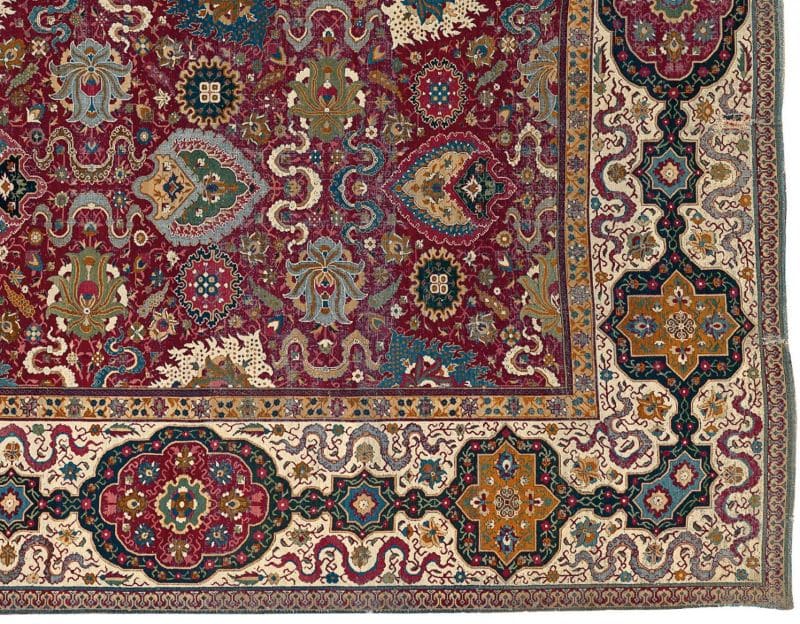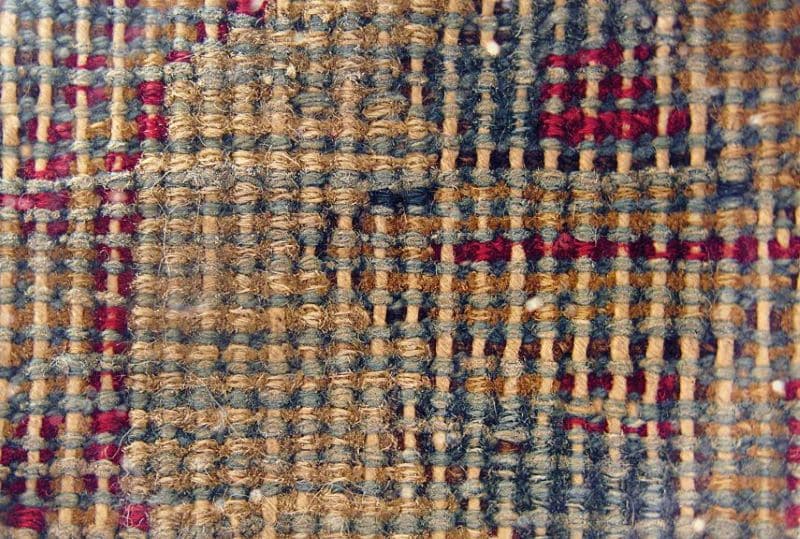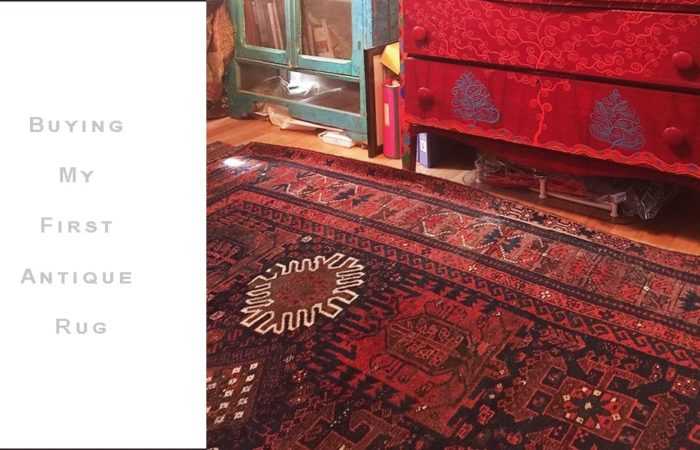Mystery of the Trinitarias Carpet: Is It a Fake?
The issue of forgery is always a question when it comes to antiquities of all types. History is full of people being duped by some complex and quite realistic looking forgeries. In one case during the 1930’s, a man once claimed to have a piece of silver created on Paul Revere’s forge. As it turned out, this piece, along with much of the collection, was not actually silver but was aluminum alloy.
This metal would not even be invented for another 200 years after Paul Revere’s famous ride. The world of fine carpets is not without its share of mysteries. Many know the story of the great antique rug forger Theodor Tuduc. But there is more mystery in the rug world and the Trinitarias carpet is one of the greatest mysteries in the world of carpet collecting.
Let’s explore this piece further.

The Trinitarias Carpet.
The Trinitarias Carpet
The Trinitarias carpet resides in the collection of the National Gallery of Victoria in Melbourne, Australia. The carpet has a wool pile, cotton warp, and cotton weft. The carpet has a primarily red field, a central medallion, and pendants. It has a large border with a series of cartouches that are linked. The Trinitarias carpet is finely detailed and has a field of floral motifs.
The Trinitarias carpet is an impressive piece for its artistry and size and measures 34.25 feet long by 11.02 feet long (10.44 x 3.36 meters). It is a magnificent piece that features a brilliant sixteen-lobed medallion with a white background, split-leaf, and floral palmette designs. The knot counts in identical floral motifs are different, which indicates a paper cartoon, rather than a graph paper knot plan.
The carpet is an impressive piece that was created with the asymmetrical, or Persian knot. It has a knot count of 120-130 knots per square inch. From all appearances, this carpet appears to have been produced by the great carpet centers during the Safavid Dynasty in the 17th century. So, what is the controversy?

A close up of the corner of the Trinitarias Carpet.
Appearances of the Trinitarias Carpet Might Be Deceiving
In an examination of the piece, the carpet dyes were tested in a lab and found to be consistent with plant dyes used in the 17th century. Carbon dating also confirmed the date of the carpet to be from this period, but it was considered to be of limited reliability. So far, everything seems to point to this carpet representing a rare masterpiece of the mid-17th century. Still, some scholars of carpet history argue that this carpet may be a later creation or even a modern rug fake.
The carpet was supposedly a gift from Prince Philip IV of Spain to the nuns at Trinitarias Del Calzas. A Persian carpet such as this would have been quite an expensive gift for a convent of nuns who were called the “barefoot nuns” for their lack of footwear, even in the cold. And here is where the mystery begins.
The Trinitarias carpet has recently been questionably attributed to Northern India, which would have been a much less expensive gift than a Persian masterpiece. Did Prince Philip indeed give the nuns a cheaper quality rug, passing it off as a more expensive one? Another question is how it remains in such good condition when most of the antique rugs from that time have long disintegrated.
According to the rug’s story, the carpet spent the first four centuries keeping the chill off the toes of the nuns. In 1938, it was exhibited at the World Fair in Seville. It was then sold to a Spanish gallery located in London. During World War II, it was sent to Canada to keep it safe. This was the fate of many European antiquities.
After the war, it went into the hands of a prominent Glasgow carpet maker. They proceeded to reproduce the design and use it in their machine-made Chenille rugs. In 1959, they sold the carpet to the National Gallery Victoria.

The Trinitarias Carpet on display at the National Gallery of Victoria in Melbourne.
Robust Arguments for Deception of the Trinitarias Carpet
In 2012, Walter Denny argued that the story involving the nuns and Prince Phillip is intriguing, but that it is more legendary than factual. Secondly, he assigns the production of the carpet to India rather than Persia. Let’s take a look at his evidence.
The first analysis that Denny conducted was to examine the carpet for evidence of a “Jufti” knot, which would have eliminated the possibility of Indian production. This type of knot goes over two sets of warp threads rather than one and is a technique only found in Persian carpets. No Jufti knots were found, so the origin was still up in the air.
Next, Denny examined the entire carpet using an optical loupe, and digital photos were taken with a zoom lens. At this point, chemical analysis of the dyes, carbon dating, and a physical examination of the carpet all point to its early Persian origins. So, what gives?
Denny’s argument comes from a structural analysis of the carpet performed by carpet historian Susan Scollay of Melbourne. First, the dates of the arrival of the carpet at the convent are muddied. It was first mentioned in the convent records in 1699, but Philip IV ruled from 1621 -1625. Why wasn’t such an important gift recorded when it was given?
The mystery deepens. When the carpet was first offered for sale in 1926, the buyer examined the convent records and discovered that the carpet was indeed gifted to the convent on February 5, 1699, by Don Juan de Guzman. The gift was supposedly in honor of Sister Josefa de la Encarnacion, who had recently entered the convent. At least King Philip IV is off the hook for offering the nuns an inferior carpet. However, the records of this gift were apparently destroyed during the Spanish Civil War between 1936-1939, so we will never know for sure if the purchaser was telling the truth.

Details of the back of the Trinitarias Carpet taken by Walter Denny, showing the weft.
Trinitarias Carpet: From India or Persia?
With these records lost, the next important question becomes whether the carpet is from India or Persia. So far, the evidence is decidedly in favor of Persia, but Denny was not so sure. The question comes down to an examination of the spinning and weaving technique. As a general rule, the warp of Persian carpets typically includes four or fewer strands twisted together like a cable, referred to as plying. There are a few exceptions, but in general, carpets with more than four strands in the warp are of Indian origin. The Trinitarias carpet uses 8 strands for the warp.
Another argument for Indian origin comes from an examination of the color. The design has what is called ton-sur-ton. This is also typical in Indian carpets, but not in Persia. The Indian dyers were much more skilled in the production of various shades of color. The Trinitarias carpet shows the ton-sur-ton coloring of Indian carpets. Indian carpets will use the placement two different shades of the same color to create the design. For instance, the Trinitarias carpet light pink cloud bands on a deeper pink background. This is seldom seen in Persian carpets.

A cartouche showing the ton-sur-ton technique on the Trinitarias Carpet.
There is evidence that during the 17th and 18th centuries, the Dutch East India Company imported massive numbers of Indian carpets to Portugal and Spain, but all of this evidence is circumstantial. Is it enough to discard the carbon dating and dye analysis? Is it from Persia, or is it a later Indian forgery of an earlier Persian carpet? Unfortunately, these questions remain a mystery and are a touchy matter among collectors. There is undoubtedly evidence of support on both sides.
One thing is for sure, the Trinitarias carpet is one of few in a select group of this magnificence and beauty. Regardless of its true provenance, it is still a world heritage carpet that continues to remain a mystery, even in this age of technology and knowledge. This mystery may never be solved, but we invite you to look around our beautiful collection. Perhaps you will find your masterpiece.
This rug blog about the Trinitarias carpet was published by Nazmiyal Antique Rug Gallery In NYC.



